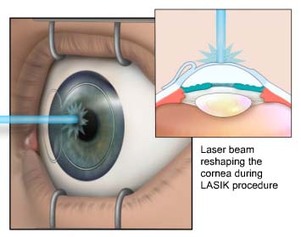
LASIK eye surgery is available for ideal candidates who are in need of vision correction surgery. While many folks think there is only one kind of LASIK, there are actually three:
OptiLASIK utilizes the latest laser technology to make a corneal flap. The entire procedure is completed without a blade. After the flap is made, the laser reshapes the cornea until the necessary shape is reached. Short and sweet, the procedure itself only takes 10-15 minutes for both eyes. PRK (Photorefractive Keratectomy) LASIK eye surgery removes the corneal cover in roughly 10 seconds. Also termed Epi-LASIK, LASEK and Advanced Surface Ablation, the cornea is then reshaped using state-of-the-art technology like the Allegretto Eye-Q Laser.
The third form of LASIK eye surgery is Monovision. This procedure differs from the previous two a bit. While advanced laser technology is used to fix the vision problem, monovision sets a patient’s non-dominant eye to be focused for near vision while the dominant eye is set for distance. After LASIK eye surgery is complete, the patient’s brain will adapt to the vision changes, allowing for improved and balanced vision for both eyes. The dominant eye will now be useful for distance while the non-dominant is helpful for closer tasks such as reading. “Test driving” this procedure for a temporary time is essential in ensuring it is the best LASIK option for the patient.
If you’re interested in LASIK eye surgery, consult a reputable eye care doctor who specializes in LASIK procedures and offers straightforward pricing options.
- OptiLASIK - All Laser Blade Free LASIK
- PRK - Blade-Free LASIK
- Monovision
OptiLASIK utilizes the latest laser technology to make a corneal flap. The entire procedure is completed without a blade. After the flap is made, the laser reshapes the cornea until the necessary shape is reached. Short and sweet, the procedure itself only takes 10-15 minutes for both eyes. PRK (Photorefractive Keratectomy) LASIK eye surgery removes the corneal cover in roughly 10 seconds. Also termed Epi-LASIK, LASEK and Advanced Surface Ablation, the cornea is then reshaped using state-of-the-art technology like the Allegretto Eye-Q Laser.
The third form of LASIK eye surgery is Monovision. This procedure differs from the previous two a bit. While advanced laser technology is used to fix the vision problem, monovision sets a patient’s non-dominant eye to be focused for near vision while the dominant eye is set for distance. After LASIK eye surgery is complete, the patient’s brain will adapt to the vision changes, allowing for improved and balanced vision for both eyes. The dominant eye will now be useful for distance while the non-dominant is helpful for closer tasks such as reading. “Test driving” this procedure for a temporary time is essential in ensuring it is the best LASIK option for the patient.
If you’re interested in LASIK eye surgery, consult a reputable eye care doctor who specializes in LASIK procedures and offers straightforward pricing options.
 RSS Feed
RSS Feed